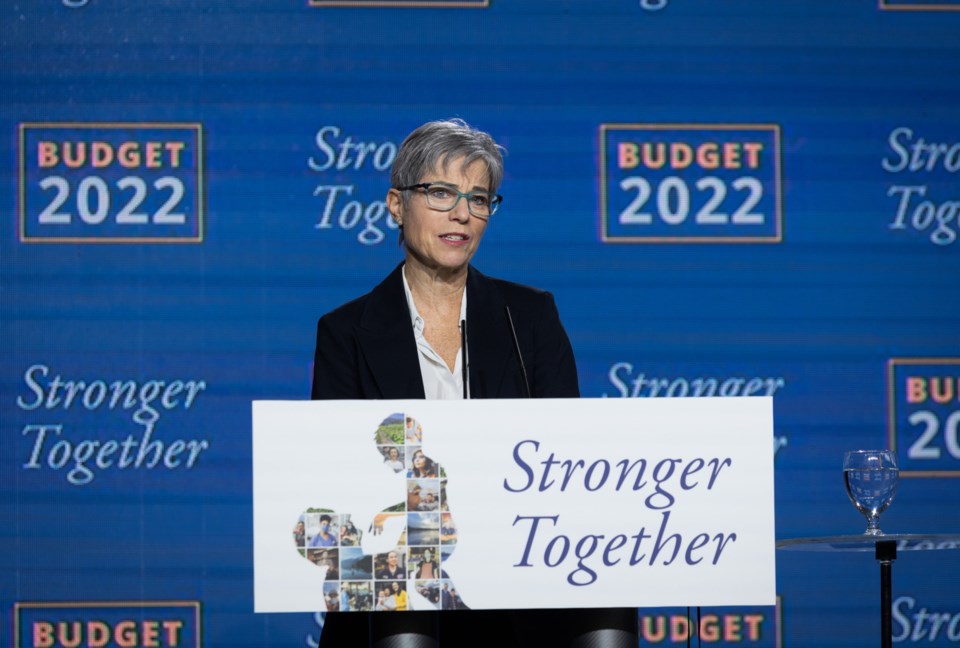In every budget – yes, even in a pandemic – the first thing you notice is the bottom line.
This year’s deficit is a little more than $5.4 billion, a number that would have wet beds even two years ago. But in the age of pandemic spending, this figure barely raised an eyebrow.
What about debt? COVID-19 made this seem almost irrelevant at times. Alas, it is all too real, and continues to climb, now up to $105,431,000,000 – or about $20,275 for every person in British Columbia. The province’s debt to GDP and debt to revenue ratios also continue to increase.
Much of the deficit doesn’t require much explanation. The pandemic, wildfires, floods, and much else continues to dominate spending. This is in part due to aid, but also new programs, such as a newly year-round BC Wildfire Service.
“Disasters are expensive” is far from the whole picture. For example, the provincial government’s forestry policies are expected to mean $1 billion less in annual revenue by 2024 – a massive hole that, by then, will likely mean the difference between balancing the budget and more years of deficits and increasing debt.
Taxpayer-supported capital spending is also going way up. The next three years will see $27.4 billion in new projects – that’s up from $17.4 billion over the previous three years. This is a sign both of new projects and escalating construction costs.
The government is creating a new ministry, Land Water and Resource Stewardship, which has the unfortunate acronym of Land WARS. With a budget of $82 million, it’s one of the smaller ministries in government, dwarfed by the ministry it’s (largely) being split off from. The Ministry of Forests (still) has a budget in excess of $1 billion. Provincial officials say they’ll unveil more details in the coming weeks, not least of which is the minister themself. (Is that Nathan Cullen’s music?)
The province is also creating another new body. The Declaration Act Secretariat that will “guide and assist government to meet its obligation to ensure legislation is consistent with the UN Declaration on the Rights of Indigenous Peoples, and developed in co-operation with Indigenous Peoples.” With a budget of just $12 million over three years, it’s a small office, not unlike the old Confidence and Supply Secretariat that underpinned the NDP’s then-minority government.
On two major and problem files, the province is relying heavily on Ottawa – which is coming through on one, but not the other.
On childcare, federal funding is the crucial component towards meeting the NDP’s original campaign promise of $10/day fee, or this budget’s target of an average fee of $20/day. The budget touts $284 million in provincial funding, which is lovely, but you have to dig past the news release to find the more important number of $3.2 billion over three years from the federal government – without which these targets aren’t even remotely feasible.
But on more general healthcare funding, Ottawa has thus far not brought deliverance. Finance Minister Selina Robinson is reduced to essentially just pleading for more money – which isn’t new, or even unique to BC. But it’s unusual to see what amounts to a full-page ad in provincial budget materials making the case for more federal funding.
Where this budget will be criticized is in BC’s three major problem issues.
First and foremost, the overdose epidemic. Despite setting grim new records every month, the crisis still struggles to command much attention from the provincial government. In the minister’s budget presentation, it didn’t even warrant its own dedicated slide, but a general line “supporting the delivery of mental health and addictions services” on the Prioritizing Health slide.
Perhaps the saddest and most grim line item in the budget is a $12 million increase for the coroner’s service – necessary, because they are unfortunately quite busy. Meanwhile, more money for the Ministry of Mental Health and Addictions is almost entirely being used for more communications and ministry staff.
Second, affordability. Businesses hanging on by a thread throughout the pandemic continue to face mounting costs, from paid sick days, increased property and carbon taxes, the employers' health tax, and inflation won’t see much immediate relief in this budget.
The provincial government’s biggest headache is still the cost of housing.
This year saw massive jumps in home prices, quite literally across the board. While the Fraser Valley (up 21%) and Greater Vancouver (up 12%) stand out, every region saw price growth of over 10%.
The good news: the province expects these increases to be tempered in 2022/23…because of rising interest rates. But rising interest rates are also listed as a risk to the province’s overall fiscal projections. And higher interest rates will stretch homeowners’ budgets, making life less affordable.
In other words, home prices will continue to rise, but not as much, because of something the province can’t control, which will also jeopardize the overall budget.
Maclean Kay is Editor-in-Chief of The Orca



